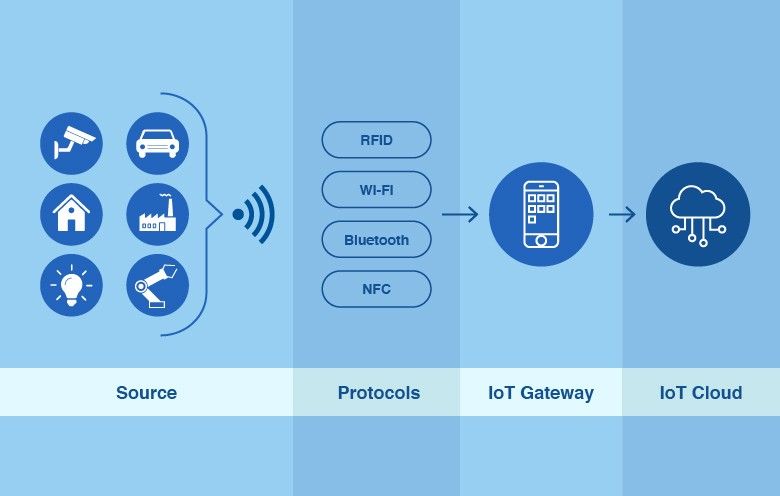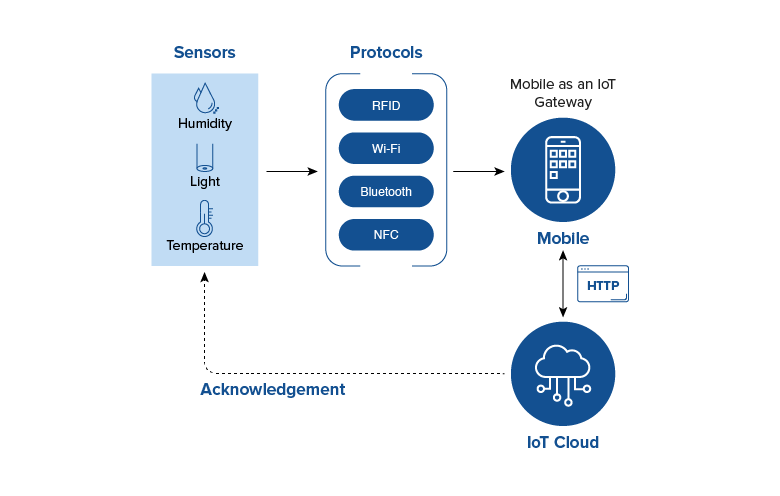Can we think of a world without bridges? Likewise, IoT gateway is an indispensable part of an Internet of Things (IoT) architecture. IoT gateway brings IoT networks to life. Without IoT gateways, and now without IoT mobile app development, the wild west of IoT devices cannot connect with the sophisticated IT world. This becomes more valuable with the estimation of connected IoT devices in 2025 by IDC:
Any physical thing or device (sensors, actuators, objects, meters, displays and so on) connects into IoT network through many ways:
- Direct connectivity between the device and the IoT platform
- Connect through an IoT mesh network
- Connect to an IoT gateway
- No connectivity
Imagine a humidifier reports moisture level every second. What if each reading is sent to the cloud? Naturally, the amount of data from one device would go massive. Multiply that by billions of devices. Of course, not every piece of data is taken into use for analysis. Companies use a subset of data for viewing or further analysis. That’s where data filtering comes in. Data filtering is just one of the tasks that an IoT gateway performs. An IoT gateway does many other tasks as shown below:
- Protocol conversion
- Local decision-making
- Local filtering and aggregation of data
- Applications/functions not delivered by the IoT endpoints
- Communication to the cloud and the IoT platforms
- Local additional processing power and storage
- Local security
Why do you need an IoT gateway?
A network of a physical thing or device is the most obvious layer in IoT architecture. But those physical things or devices have limited connectivity capabilities. Sensors use Bluetooth low energy (BLE) for low-power wireless communications or ZigBee, local area network (LAN), home area network (HAN) and personal area network (PAN). These protocols cannot directly connect to larger networks like wide area networks (WAN) or the Internet. That’s why an IoT gateway is essential. It offers sensors a single point of contact with external networks using Wi-Fi, GSM, Bluetooth, or other types of connectivity.
Our smartphones already have these capabilities inbuilt. The combination of massive wireless connectivity and rich cellular networks provides uninterrupted access to the Internet. On the other hand, the tsunami of embedded, tiny, low-power, wearable, IoT and many more devices cannot enjoy the same level of universal access to the Internet. Here is where the IoT mobile app architecture fulfills this gap.
Limitations of industrial gateway
In a popular approach, most industrial gateways directly connect with enterprise systems. But today, customers need customized gateways as per their IoT devices and applications. Hence, direct connections to enterprise systems are not helpful. The other fact is that software tailoring in gateways slows down IoT solution development and deployment process. It also increases costs at every stage of the IoT product lifecycle. The situation is impeding the growth of IoT. Moreover, latency, easy and quick integration as well as configuration of the devices, uninterrupted operations, and valuable user interface are other challenges with most industrial gateways.
The solution to all these challenges is a low-power, ubiquitous, last-inch networking approach facilitated by Wi-Fi and BLE. Almost all smartphones have these inbuilt. And the global network of cellular networks can easily fulfill all the limitations of industrial gateways. Hence, using mobile as an IoT gateway can take IoT solution development and deployment to a new level.
Applications of mobile as an IoT gateway
Ambient data collection
Poor connectivity, expensive data links, or device power constraints are barriers that make data retrieval from each device challenging. A mesh network of sensors can allow data packets to hop through the network. The solution often does not work in areas with challenging RF characteristics. Also, the demands of packet forwarding consume the sensor’s life substantially.
In contrast, IoT mobile app architecture leverages smartphones’ inbuilt capacities for data collection from installed sensors. Consider old buildings or legacy machines with poor RF characteristics. Though sensors are deployed, data collection seems challenging. Here, facility managers can use daily occupants’ integrated IoT mobile apps with their permissions. That way, companies do not need to install costly industrial gateways or invest in maintenance.
Multiplatform connectivity
Most wearable devices connect to specific smartphones – the Apple watch pairs with the iOS device. Motorola and Samsung smartwatches also follow a similar model. Such a brand-centric, closed, siloed approach is a barrier to the potential usefulness of such devices.
With an open IoT architecture using mobile as a gateway, any smartwatch can ask any smartphone to act as a gateway. It is useful for applications that are running on the device to consume low-bandwidth Internet. Nevertheless, certain user-specific applications may still need a specific app compatible with those devices. This is valuable for making IoT applications available to a large group of people in a cost-effective manner. Overall, multiplatform connectivity is the biggest advantage of using mobile as a gateway.
Masking industrial gateway failures
Imagine if an industrial gateway faces either external or internal damage and loses its ability to send or receive data. Then an open gateway IoT architecture allows devices to use any smartphone to forward and receive data. In situations where a smart wireless glucose monitoring system is used, it is crucial not to lose functionality because of any error in the industrial gateway. In such cases, using mobile as a gateway is vital.
Mobile as a gateway architecture
Near-constant connectivity, ubiquity and mobility make smartphones a universal IoT gateway. Mobile as an IoT gateway performs all the tasks described in the first image.
In the architecture shown above, the mobile stays in the center while all IoT devices act as peripherals. IoT devices transmit data packets and notify central nodes about their presence. Once a mobile gateway receives a packet, it establishes a connection with the Internet and transfers information.
Parameters of data flow from IoT devices like the type of data, content, destination and the rate of data to be forwarded must be defined. The gateway creates a bundle on receiving the data and sends it as an HTTP POST to the specified destination. Here, IoT mobile apps play a key role in customized IoT applications. Moreover, the integration of mobile apps with IoT is important when peripheral nodes request an acknowledgment. TCP or UDP facilitates it in near real-time.
To conclude
Mobile as a gateway enables an open IoT structure, promoting the development and growth of IoT networks quickly. If successfully deployed via the global smartphone infrastructure, it can expedite the growth of IoT networks cost-effectively and conveniently.
Your IoT architecture should send which and what types of data? Should there be data size and data transfer rate limits? If IoT devices disconnect or move away, how does a mobile IoT gateway responds? Can a mobile gateway stores data and forward later? Can this gateway send updates to IoT devices? If the mobile gateway cannot connect to the Internet immediately, how long can it hold data? – to know more about such things, contact us.





